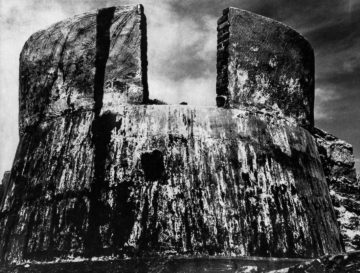Brian Dillon at Artforum:
 EARLY IN JULY 1958, the Japanese photographer Kikuji Kawada, then aged twenty-five and a staffer at the weekly magazine Shukan Shincho, visited Hiroshima for a cover story to run in the month following. He was there to photograph another photographer, Ken Domon, whose book Hiroshima had been published in the spring. Among Domon’s subjects: the scarred bodies of survivors of the atomic-bomb attack of August 6, 1945, and the skeletal dome of the city’s riverside industrial exhibition hall. When he had finished his assignment, Kawada lingered in the ruins below the Genbaku Dome, where brick and concrete walls were covered with stains composing, as he put it, “an audibly violent whirlpool.” Kawada took no photographs of the enigmatic markings, but returned two years later with a 4 x 5 view camera, and began making long exposures in “this terrifying, unknown place.”
EARLY IN JULY 1958, the Japanese photographer Kikuji Kawada, then aged twenty-five and a staffer at the weekly magazine Shukan Shincho, visited Hiroshima for a cover story to run in the month following. He was there to photograph another photographer, Ken Domon, whose book Hiroshima had been published in the spring. Among Domon’s subjects: the scarred bodies of survivors of the atomic-bomb attack of August 6, 1945, and the skeletal dome of the city’s riverside industrial exhibition hall. When he had finished his assignment, Kawada lingered in the ruins below the Genbaku Dome, where brick and concrete walls were covered with stains composing, as he put it, “an audibly violent whirlpool.” Kawada took no photographs of the enigmatic markings, but returned two years later with a 4 x 5 view camera, and began making long exposures in “this terrifying, unknown place.”
The book that resulted, Chizu (The Map), first published in 1965, is one of the wonders of postwar Japanese photography, as much in Kawada’s approach to the form and boundaries of the photobook as his singular address to the atomic history that was then exercising Japanese artists as well as antinuclear activists.
more here.
